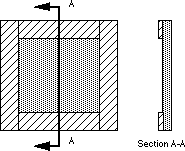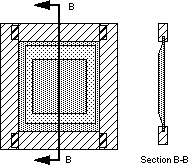
Simulated frame and panel construction:
This method is used on some inexpensive furniture to get the appearance of more expensive construction techniques. This method may be acceptable for furniture that is not expected to last a long time, or which will be protected from the weather and from changes in humidity.
The "panel" is actually a plywood sheet the full size of the piece, while the butt-jointed "frame" is applied to the panel's surface with glue and/or nails. The "panel" must perforce be flat within the "frame", unless a raised decorative area is glued or nailed to the surface of the panel. If the panel and the frame are both done in solid wood, expansion and contraction with changes in humidity will eventually damage it.
Section view A-A is a cross-section through the thickness of the piece.

True frame and panel construction:
The panel is a solid wood piece, fitted into grooves on the inside of a joined wooden frame. The panel may be (and usually is) shaped thinner at the edges and is often covered with carved or pierce work decoration. The corners of the frame are joined with mortise and tenon joints (a rectangular projection on the ends, cut with the grain, tightly fitted into a rectangular hole cut across the grain, and held by pegs and glue). The result is strong, light, and allows solid wood in frame and panels to expand and contract without damage to the piece.
Historical pieces made in this manner have lasted for centuries, with no damage caused by the expansion or contraction of the wood as the humidity changes.
Section view B-B is a cross-section through the thickness of the piece.